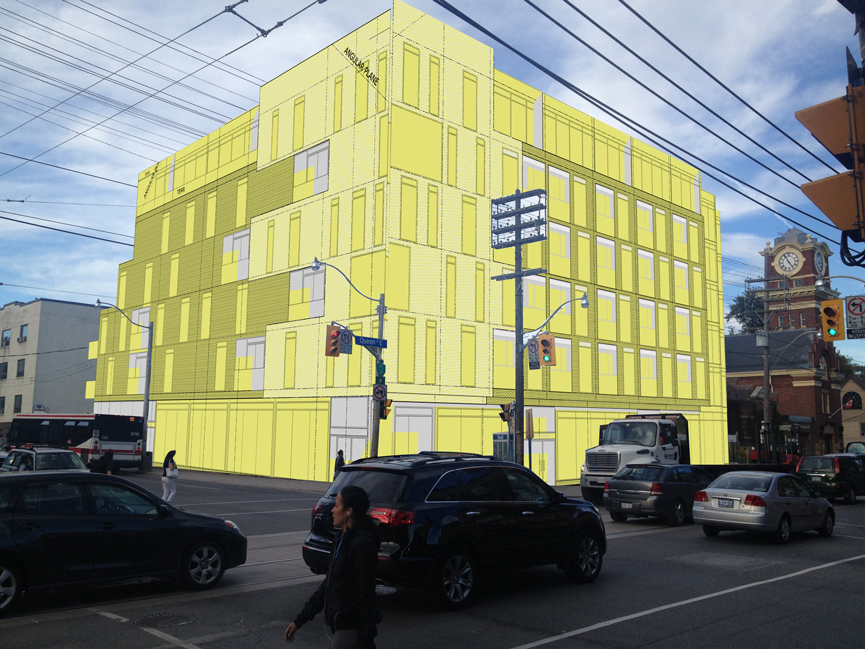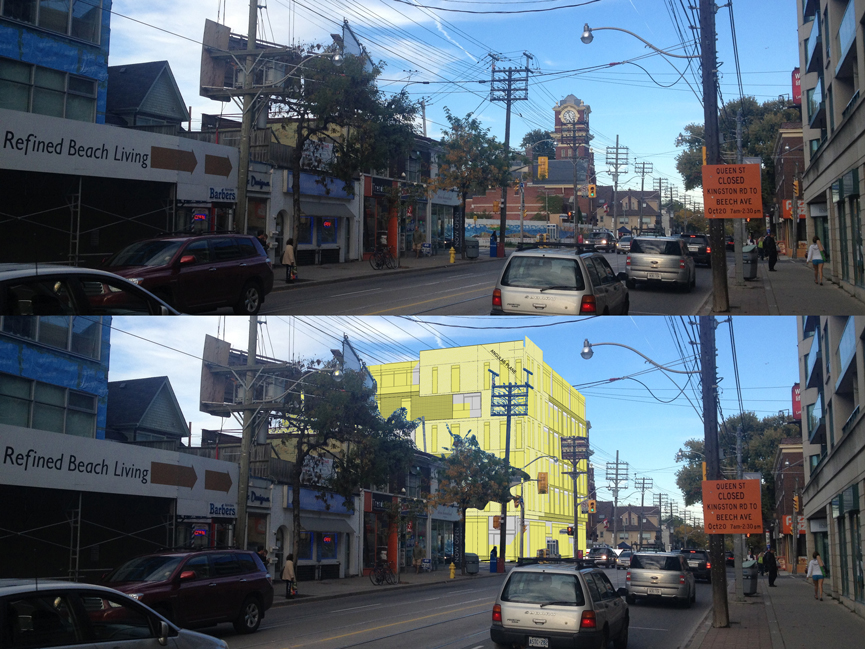… ensuring new developments do not violate existing urban design guidelines, respect the scale and character of the surrounding area, include affordable units, and increased density is integrated and timed with increased public transit.
Development has been a contentious issue in this area for years now, in particular on Queen St.
Opponents fear losing the character of the area, supporters feel it will inject new life and better support local business.
Only time will reveal the true impacts on the neighbourhood, good or bad.
Some residents argue that certain developments feel out of place, and are an intrusion on the neighbourhood. There is no question that past OMB decisions have very much favoured developers and ignored residential concerns.
The Shell Station
One such upcoming development is the Shell Station site on the northeast corner of Queen and Woodbine.
I was part of the OMB fight on behalf of the Beach Village BIA, in collaboration with the GBNA. Even the city fought alongside us.
Despite the fact urban design guidelines were developed by the community in co-operation with the city and developers, and those guidelines are now a part of the Official Plan, the developers submitted a design that went well beyond what was allowed in the urban design guidelines. The OMB let it stand based on a technicality.
There was a loophole, a brief window of time in which the guidelines had been submitted to city hall, but had not yet been passed. The developer snuck their application in during that window.
Nothing mattered to the OMB member deciding the case, beyond the fact that the date of the application was before council had passed the guidelines. There was a lot of time and money wasted on lawyers.
So, now the development violates an entire section of the urban design guidelines, a section with very specific measurements of the sightlines of our historic firehall to be maintained.
As councillor, I will fight hard to see the guidelines respected and this development forced to conform to them.
Main & Danforth
Another concerning development is at Main and Danforth, where there are some very large towers planned for the area. It is disappointing to lose Main Square, but these towers have been in the works for years and are a done deal.
In this case, however, it is less the scale and scope of the development that is of concern, as there are already towers there, but rather the capacity of local transit to deal with an influx of hundreds of new residents.
GO RER and SmartTrack are in doubt, with no solid timelines, and the Relief Line is well over a decade away with no funding yet.
Subway trains are already packed most mornings during rush hour, and adding more people to the crush will only worsen the problem.
Main and Danforth is a prime example of the need to time the addition of new density with new mass transit.
Another concerning development, which the city is questioning, is the office tower idea across from Main Square. Thankfully the design is going to require some rethinking, because the initial plan was not in the best interests of the community.
The Growth Plan
The Growth Plan is a very lopsided document, and it prioritizes residential development with seemingly specific targets that are allowed to be exceeded.
It completely disconnects any of that from mass transit, the only target being that the horizon for viable transit is supposed to catch up by 2041. Talk about kicking the can down the road.
The major issue with this disconnect is that it’s really easy to let the private sector build development after development. With our constantly shifting politics in the province and at city hall, governments have put not just transit planning in doubt, but funding as well.
The Growth Plan allows too much leeway to overbuild developments that are completely divorced from any considerations of transit or transportation infrastructure.
There are many concrete plans for increases in density, but only hopes that it will ever be met by corresponding mass transit.
The imposition of the province will continue, unabated, with the replacement of the OMB with LPAT, because both are driven by the Growth Plan.
Cities must incorporate changes in the Growth Plan into their official plans within 3 years.
This creates difficulties in city planning, because Toronto has a small and underfunded planning department trying to deal with the deluge of developer applications from across the city—applications which if they take too long to process, can trigger legal challenges from the developer.
Transportation Planning
Unfortunately, city staff do not have the time to properly consider or plan more holistically, and worse, they have no say in council decisions that may hamper efforts to meet new density with new transit.
Were it not for Mayor Rob Ford’s attempt to scuttle the Scarborough LRT with misinformation, we would likely have most of it built by now instead of watching the costs of a subway not supported by evidence continue to bloom.
Pushing for transit expansion in tandem with increased density is also important because of the city’s policy of “auto-minimization”—which means new developments are now built with fewer parking spots than units, in order to encourage more transit ridership and less car ownership.
I was informed of this policy by a city planner when I and other concerned GBNA members met with him.
We implored him to consider the impacts if those people denied parking spots tried to get street parking instead, but our concerns were rebuffed. While this policy may make sense on paper, it’s not clear how it will play out in reality.
Especially when transit service is so inefficient that many do not consider it to be a viable alternative. A Beaches-East York resident can drive downtown in 15-20 mins or take 45mins-1hr to take transit.
As councillor it is not easy to stop or slow development. But I will do my best to ensure it respects the neighbourhood it is joining, and that considerations are made for the increased transit needs that come with increased density.
Affordable Housing
Affordable housing is an increasingly important issue in an economy where middle and lower income wages are stagnating while inflation keeps eroding people’s purchasing power.
The backlog of repairs to TCHC housing is a tragedy, and the repeated mismanagement of the agency borders on criminal. It’s not clear why the city can’t seem to hire someone up to the task of ensuring stable housing for our most vulnerable.
The TCHC sell-off of over 800 units to non-profits is of dubious benefit. On the surface it seems like a good idea: allow someone else to take up the administration, management, and repairs of affordable housing. But it’s not clear if we’ll get market value for the properties, if these non-profits will also have the money to repair them, and if they will be maintained and managed to a proper standard. It’s also not clear how the city will ensure none of these properties are sold into private hands. Lastly, it creates a degree of separation between tenants and the city, so it may be harder for the city to track the management of these properties.
More importantly, the city should not need to cajole and entice private developers to include affordable housing by giving them incentives such as tax breaks or subsidies. The inclusion of affordable units in new multi-residential buildings should be a legal requirement. Inclusionary zoning attempts to address this, and it’s a start, but it seems there are some very deep flaws to the program.
An even better solution is if TCHC stopped relying on private developers altogether and became their own developer. If the private sector doesn’t like building affordable units, then we should simply build what is needed ourselves. This is another area where the federal government should be aiding cities with federal grants and public subsidies. If the feds can subsidize the fossil fuel and mining industries to the tune of billions per year, they can easily shell out for affordable housing.
A troubling statistic is how many affordable housing complexes have become crime-ridden and are housing people with mental health issues who should really be taken care of in the proper institution. Low income seniors in East York are being shook down by new tenants shifted from downtown units. As income inequality worsens combined with an aging population, we need to ensure low income seniors have a stable secure place in which to live.


